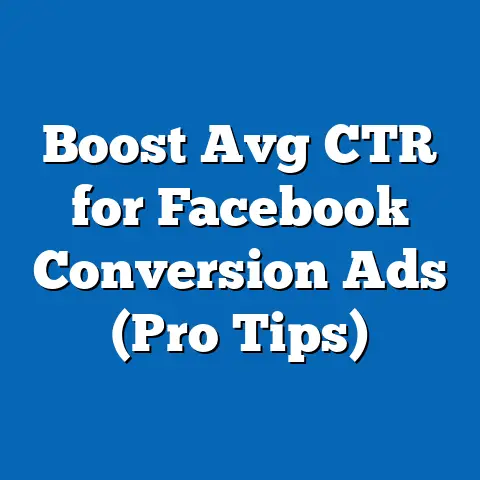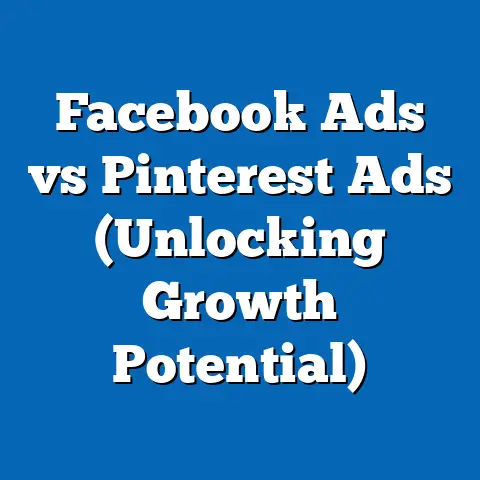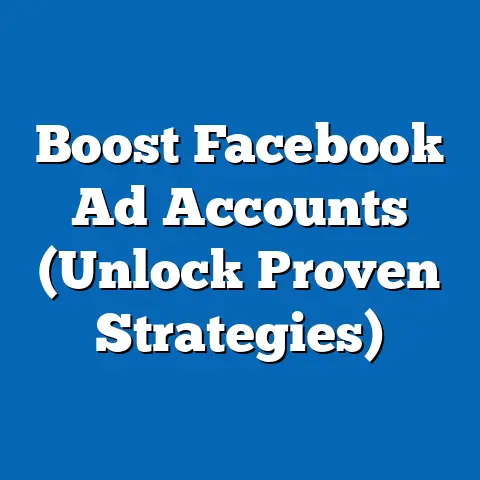Change Facebook Ads Location Easily (Expert Tips Inside)
Facebook advertising has revolutionized how businesses connect with their target audiences. What I find particularly compelling is its affordability, especially for small and medium-sized enterprises (SMEs). Unlike traditional advertising methods that often require significant upfront investment, Facebook allows you to reach a vast audience without breaking the bank. I’ve seen firsthand how local businesses, with limited marketing budgets, have managed to compete effectively against larger corporations simply by leveraging the power of Facebook ads. One of the key features that make Facebook ads so versatile and valuable is the ability to change ad locations effortlessly. This flexibility allows you to optimize your campaigns in real-time, ensuring that your ads are seen by the right people, in the right places, at the right time. In this article, I’ll guide you through the process of changing ad locations on Facebook, sharing expert tips and insights to help you maximize your advertising ROI.
Understanding Facebook Ad Locations
Facebook ad locations refer to the various places where your ads can appear on the Facebook platform and its related properties. These locations include:
- Facebook News Feed: This is the primary location where most users spend their time, making it a prime spot for your ads.
- Instagram Feed: Since Facebook owns Instagram, you can easily run ads on Instagram’s main feed, reaching a younger, visually-oriented audience.
- Instagram Stories: These short-form video and image ads are highly engaging and perfect for capturing attention quickly.
- Facebook Marketplace: If you’re selling products, the Marketplace is an excellent location to showcase your items to potential buyers.
- Facebook Watch: Video ads can be placed within Facebook Watch, targeting users who are actively watching video content.
- Audience Network: This extends your ads to a network of third-party apps and websites, allowing you to reach users beyond the Facebook ecosystem.
- Messenger: Ads can appear in the Messenger app, either in the inbox or as sponsored messages, providing a direct line of communication with your audience.
Selecting the right ad location is crucial for targeting specific demographics and maximizing ad performance. For instance, if you’re targeting a younger audience, Instagram Stories might be a better choice than the Facebook News Feed. Conversely, if you’re promoting a product for older adults, the Facebook News Feed might be more effective.
I remember working with a client who was launching a new fitness app. Initially, they were running ads solely on the Facebook News Feed. While they were getting some traction, the engagement wasn’t as high as they had hoped. After analyzing their target audience, we realized that many of their potential users were active on Instagram. We decided to shift a portion of their budget to Instagram Stories, and the results were remarkable. Engagement rates soared, and they saw a significant increase in app downloads. This experience taught me the importance of understanding where your target audience spends their time and tailoring your ad placements accordingly.
According to recent statistics, ads placed on Instagram Stories tend to have higher engagement rates compared to those on the Facebook News Feed, particularly among younger demographics. Studies have also shown that ads placed in the Facebook Marketplace can lead to higher conversion rates for e-commerce businesses.
Key Takeaway: Understanding the different Facebook ad locations and aligning them with your target audience is essential for maximizing ad performance.
Steps to Change Facebook Ad Locations
Changing ad locations in Facebook Ads Manager is a straightforward process. Here’s a step-by-step guide to help you navigate the process:
Step 1: Accessing Ads Manager
First, you need to access the Facebook Ads Manager. You can do this by logging into your Facebook account and navigating to the Ads Manager through the left-hand menu or by directly typing “Facebook Ads Manager” into the search bar.
Step 2: Selecting the Campaign You Want to Edit
Once you’re in the Ads Manager, you’ll see a list of your campaigns. Select the campaign you want to edit by clicking on its name.
Step 3: Navigating to the Ad Set Level
Within the campaign, you’ll find one or more ad sets. Ad sets control the targeting, budget, and placement of your ads. Click on the ad set you want to modify.
Step 4: Modifying the “Placement” Settings
In the ad set settings, scroll down until you find the “Placement” section. Here, you have two options:
- Automatic Placements: This allows Facebook to automatically place your ads across all available locations based on their algorithm. While this can be convenient, it’s often better to have more control over where your ads appear.
- Manual Placements: This option allows you to choose specific locations for your ads. I highly recommend using manual placements, especially when you have a clear understanding of your target audience and their preferred platforms.
If you choose manual placements, you’ll see a list of all available locations, including Facebook News Feed, Instagram Feed, Audience Network, and more. Simply check or uncheck the boxes next to each location to select or deselect them.
Step 5: Saving Changes and What to Expect Post-Change
Once you’ve made your desired changes, scroll to the bottom of the page and click “Review and Publish.” This will save your changes and update your ad placements.
After changing ad locations, it’s crucial to monitor your ad performance closely. Keep an eye on metrics like reach, impressions, engagement, and conversion rates. If you notice any significant changes, be prepared to adjust your strategy accordingly.
Key Takeaway: Changing ad locations in Facebook Ads Manager is a simple process that can be done in a few steps. However, it’s essential to monitor your ad performance after making changes to ensure that your ads are still effective.
Expert Tips for Optimizing Ad Location Choices
Choosing the right ad locations is not just about selecting the most popular platforms. It’s about understanding your target audience and aligning your ad placements with their preferences and behaviors. Here are some expert tips to help you optimize your ad location choices:
-
A/B Testing: One of the most effective ways to determine the best ad locations is through A/B testing. Create multiple ad sets with different placements and compare their performance. This will give you valuable insights into which locations are most effective for your specific campaign goals.
I once ran an A/B test for a client who was promoting a new line of organic skincare products. We created two ad sets: one targeting the Facebook News Feed and the other targeting Instagram Feed. After running the ads for a week, we found that the Instagram Feed ad set had significantly higher engagement rates and conversion rates. Based on these results, we decided to shift more of the budget to Instagram Feed, which ultimately led to a higher ROI. * Mobile vs. Desktop: Consider whether your target audience is primarily using mobile devices or desktops. If they’re mostly on mobile, prioritize mobile placements like Instagram Stories and Facebook Mobile News Feed. If they’re on desktops, focus on placements like Facebook Desktop News Feed and Facebook Right Column. * Audience Insights: Utilize Facebook Audience Insights to gain a deeper understanding of your target audience. This tool provides valuable information about their demographics, interests, behaviors, and preferred platforms. Use this information to tailor your ad locations to their specific preferences. * Campaign Goals: Your campaign goals should also influence your ad location choices. If your goal is to drive brand awareness, consider placements with high reach, like the Audience Network. If your goal is to drive conversions, focus on placements that are more likely to lead to sales, like the Facebook Marketplace. * Content Type: The type of content you’re using in your ads should also influence your ad location choices. Video ads tend to perform well on Instagram Stories and Facebook Watch, while image ads are often effective on the Facebook News Feed and Instagram Feed.
A/B Testing: One of the most effective ways to determine the best ad locations is through A/B testing. Create multiple ad sets with different placements and compare their performance. This will give you valuable insights into which locations are most effective for your specific campaign goals.
I once ran an A/B test for a client who was promoting a new line of organic skincare products. We created two ad sets: one targeting the Facebook News Feed and the other targeting Instagram Feed. After running the ads for a week, we found that the Instagram Feed ad set had significantly higher engagement rates and conversion rates. Based on these results, we decided to shift more of the budget to Instagram Feed, which ultimately led to a higher ROI. * Mobile vs. Desktop: Consider whether your target audience is primarily using mobile devices or desktops. If they’re mostly on mobile, prioritize mobile placements like Instagram Stories and Facebook Mobile News Feed. If they’re on desktops, focus on placements like Facebook Desktop News Feed and Facebook Right Column. * Audience Insights: Utilize Facebook Audience Insights to gain a deeper understanding of your target audience. This tool provides valuable information about their demographics, interests, behaviors, and preferred platforms. Use this information to tailor your ad locations to their specific preferences. * Campaign Goals: Your campaign goals should also influence your ad location choices. If your goal is to drive brand awareness, consider placements with high reach, like the Audience Network. If your goal is to drive conversions, focus on placements that are more likely to lead to sales, like the Facebook Marketplace. * Content Type: The type of content you’re using in your ads should also influence your ad location choices. Video ads tend to perform well on Instagram Stories and Facebook Watch, while image ads are often effective on the Facebook News Feed and Instagram Feed.
Key Takeaway: Optimizing ad location choices requires a strategic approach that takes into account your target audience, campaign goals, and content type. A/B testing and audience insights are valuable tools for making informed decisions.
Common Mistakes to Avoid When Changing Ad Locations
While changing ad locations can be a powerful way to optimize your Facebook ad campaigns, it’s essential to avoid common mistakes that can lead to suboptimal performance. Here are some pitfalls to watch out for:
- Making Hasty Changes Without Data Analysis: Don’t make changes to your ad locations based on gut feelings or assumptions. Always analyze your ad performance data before making any changes. Look at metrics like reach, impressions, engagement, and conversion rates to identify areas for improvement.
- Ignoring Mobile vs. Desktop Performance: Many advertisers fail to differentiate between mobile and desktop performance. If you’re seeing low engagement rates on desktop placements, consider shifting your budget to mobile placements, and vice versa.
- Overlooking Audience Insights: Facebook Audience Insights is a valuable tool for understanding your target audience. Don’t overlook this resource when making decisions about ad locations.
- Setting It and Forgetting It: Changing ad locations is not a one-time task. It’s an ongoing process that requires continuous monitoring and optimization. Keep a close eye on your ad performance after making changes and be prepared to adjust your strategy based on real-time data.
- Not Testing Different Placements: A/B testing is crucial for identifying the best ad locations for your specific campaign goals. Don’t be afraid to experiment with different placements and compare their performance.
I’ve seen numerous campaigns fail simply because the advertiser made hasty changes without analyzing the data. One particular case involved a client who decided to shift all of their budget to Instagram Stories because they heard it was the “hottest” platform. However, their target audience was primarily older adults who were more active on Facebook. As a result, their engagement rates plummeted, and they wasted a significant portion of their budget. This experience highlighted the importance of data-driven decision-making when it comes to ad locations.
Key Takeaway: Avoid common pitfalls by analyzing data, considering mobile vs. desktop performance, utilizing audience insights, and continuously monitoring and optimizing your ad locations.
Conclusion
Facebook advertising offers unparalleled affordability and flexibility, especially for small and medium-sized enterprises. The ability to change ad locations effortlessly is a key feature that allows you to optimize your campaigns in real-time, ensuring that your ads are seen by the right people, in the right places, at the right time. By understanding the different ad locations, following the steps to change them in Ads Manager, and implementing expert tips for optimization, you can maximize your advertising ROI. Just remember to avoid common mistakes and continuously monitor your ad performance to ensure that your campaigns remain effective. I encourage you to experiment with ad location changes as a way to enhance your campaigns and achieve better results without incurring significant costs.
Call to Action:
Now that you’ve learned how to change Facebook ad locations, I encourage you to implement these tips in your own campaigns. Share your experiences or results in the comments section below. Let’s foster a community of learning and help each other achieve success with Facebook advertising!






